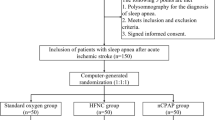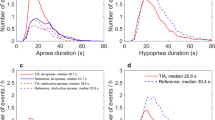Abstract
Obstructive sleep apnea syndrome (OSAS) is an independent risk factor for ischemic cerebrovascular diseases, and results in worse prognosis and higher mortality. We aimed to investigate the effects of early treatment of OSAS on the prognosis of ischemic stroke. We prospectively evaluated patients with acute supratentorial ischemic stroke and OSAS on admission (acute stage), at second week (subacute stage) and at second month (chronic stage); 11 (73.3%) out of 15 patients put on the non-invasive mechanical ventilation treatment within 48 h of stroke constituted the treatment group, and 13 patients constituted the control group. Patients with OSAS treatment showed significantly better prognosis and better functioning in activities of daily living in both subacute and chronic stages. The rate of shrinkage of the ischemic lesion was higher in the treatment group, though not significant. The early and effective treatment of OSAS provides a better clinical prognosis in ischemic stroke. The beneficial effects on radiological parameters need to be further studied.

Similar content being viewed by others
References
Arzt M, Young T, Finn L, Skatrud JB, Bradley TD (2005) Association of sleep-disordered breathing and the occurrence of stroke. Am J Respir Crit Care Med 172:1447–1451. doi:10.1164/rccm.200505-702OC
Somers VK, Dyken ME, Clary MP, Abboud FM (1995) Sympathetic neural mechanisms in obstructive sleep apnea. J Clin Invest 96:1897–1904. doi:10.1172/JCI118235
Dean RT, Wilcox I (1993) Possible atherogenic effects of hypoxia during obstructive sleep apnea. Sleep 16:15–21
Rangemark C, Hedner JA, Carlson JT, Gleerup G, Winther K (1995) Platelet function and fibrinolytic activity in hypertensive and normotensive sleep apnea patients. Sleep 18:188–194
Wessendorf TE, Teschler H, Wang YM, Konietzko N, Thilman AF (2000) Sleep-disordered breathing among patients with first-ever stroke. J Neurol 247:41–47. doi:10.1007/PL00007787
Kaynak D, Goksan B, Kaynak H, Degirmenci N, Daglıoglu S (2003) Is there a link between the severity of sleep-disordered breathing and atherosclerotic disease of the carotid arteries? Eur J Neurol 10:487–493. doi:10.1046/j.1468-1331.2003.00658.x
Bassetti C, Aldrich MS (1999) Sleep apnea in acute cerebrovascular diseases: final report on 128 patients. Sleep 22:217–223
Good D, Henkle J, Gelber D, Welsh J, Verhulst S (1996) Sleep-disordered breathing and poor functional outcome after stroke. Stroke 27:252–259
Parra O, Arboix A, Bechich S, Carcia-Eroles L, Montserrat JM, Lopez JA, Ballester E, Guerra JM, Sopena JJ (2000) Time course of sleep-related breathing disorders in first-ever stroke or transient ischemic attack. Am J Respir Crit Care Med 161:375–380
Harbison J, Gibson GJ, Birchall D, Zammit-Maempel I, Ford GA (2003) White matter disease and sleep-disordered breathing after acute stroke. Neurology 61:959–963
Kushida CA, Littner MR, Hirshkowitz M, Morgenthaler TI, Alessi CA, Bailey D, Boehlecke B, Brown TM, Coleman J, Friedman L, Kapen S, Kapur VK, Kramer M, Lee-Chiong T, Owens J, Pancer JP, Swick TJ, Wise MS (2006) Practice parameters for the use of continuous and bilevel positive airway pressure devices to treat adult patients with sleep related breathing disorders. Sleep 29:375–380
Sandberg O, Franklin KA, Bucht G, Eriksson S, Gustafson Y (2001) Nasal continuous positive airway pressure in stroke patients with sleep apnoea: a randomized treatment study. Eur Respir J 18:630–634
Wessendorf T, Wang Y, Thilmann A, Sorgenfrei U, Konietzko N, Teschler H (2001) Treatment of obstructive sleep apnoea with nasal continuous positive airway pressure in stroke. Eur Respir J 18:623–629
Iber C, Ancoli-Israel S, Chesson AL, Quan SF, for the American Academy of Sleep Medicine (2007) The AASM manual for the scoring of sleep and associated events––Rules, Terminology and Technical Specifications. AASM, Westchester, IL
AASM––American Academy of Sleep Medicine. Sleep Related Breathing Disorders. In Sateia M J (Ed), The international classification of sleep disorders, diagnostic and coding manual, second edition. AASM, Westchester, IL, pp 33–78
Hui DSC, Choy DKL, Wong LK, Ko FW, Li TS, Woo J, Kay R (2002) Prevalence of sleep-disordered breathing and continuous positive airway pressure compliance: results in Chinese patients with first-ever ischemic stroke. Chest 122:852–860. doi:10.1378/chest.122.3.852
Zozula R, Rosen R (2001) Compliance with continuous positive airway pressure therapy: assessing and improving treatment outcomes. Curr Op Pulm Med 7:391–398
Kjelsberg FN, Ruud EA, Stavem K (2005) Predictors of symptoms of anxiety and depression in obstructive sleep apnea. Sleep Med 6:341–346. doi:10.1016/j.sleep.2005.02.004
Campos-Rodriguez F, Grilo-Reina A, Perez-Ronchel J, Merino-Sanchez M, Gonzales-Benitez MA, Beltran-Robles M, Almeida-Gonzales C (2006) Effect of continuous positive airway pressure on ambulatory bp in patients with sleep apnea and hypertension: a placebo-controlled trial. Chest 129:1459–1467. doi:10.1378/chest.129.6.1459
Kaneko Y, Hajek V, Zivanovic V, Raboud J, Bradley T (2003) Relationship of sleep apnea to functional capacity and length of hospitalization following stroke. Sleep 26:293–297
Hsu CY, Vennelle M, Li HY, Engleman HM, Dennis MS, Douglas NJ (2006) Sleep disordered breathing after stroke: a randomised controlled trial of continuous positive airway pressure. JNNP 77:1143–1149. doi:10.1136/jnnp.2005.086686
Palombini L, Guilleminault C (2006) Stroke and treatment with nasal CPAP. Eur J Neurol 13:198–200. doi:10.1111/j.1468-1331.2006.01169.x
Arboix A (2009) Stroke prognosis in diabetes mellitus: new insights but questions remain. Expert Rev Cardiovasc Ther 7:1181–1185. doi:10.1586/erc.09.98
Tu HT, Campbell BC, Christensen S, Collins M, De Silva DA, Butcher KS, Parsons MW, Desmond PM, Barber PA, Levi CR, Bladin CF, Donnan GA, Davis SM, Echoplanar Imaging Thrombolytic Evaluation Trial (EPITHET) Investigators (2010) Pathophysiological determinants of worse stroke outcome in atrial fibrillation. Cerebrovasc Dis 30:389–395. doi:10.1159/000316886
Vgontzas AN, Papanicolaou DA, Bixler EO, Hopper K, Lotsikas A, Lin HM, Kales A, Chrousos GP (2000) Sleep apnea and daytime sleepiness and fatigue: relation to visceral obesity, insulin resistance, and hypercytokinemia. J Clin Endocr Metab 85:1151–1158. doi:10.1210/jc.85.3.1151
Bassetti C, Aldrich MS, Quint D (1997) Sleep-disordered breathing in patients with acute supra- and infra-tentorial strokes. A prospective study of 39 patients. Stroke 28:1765–1772
Acknowledgments
We would like to thank our colleague at Istanbul University: Naci Kocer, Professor of Radiology, for guiding our calculations on MR images. Also, we would like to thank all sleep technicians working in our Sleep Disorders Unit: Aysun Tunalı, Lokman Salbacak, Canip Ozgur, Eyup Aydın, Funda Tan, Ayser Mutlu, and Seher Kose.
Author information
Authors and Affiliations
Corresponding author
Rights and permissions
About this article
Cite this article
Benbir, G., Karadeniz, D. A pilot study of the effects of non-invasive mechanical ventilation on the prognosis of ischemic cerebrovascular events in patients with obstructive sleep apnea syndrome. Neurol Sci 33, 811–818 (2012). https://doi.org/10.1007/s10072-011-0835-6
Received:
Accepted:
Published:
Issue Date:
DOI: https://doi.org/10.1007/s10072-011-0835-6




